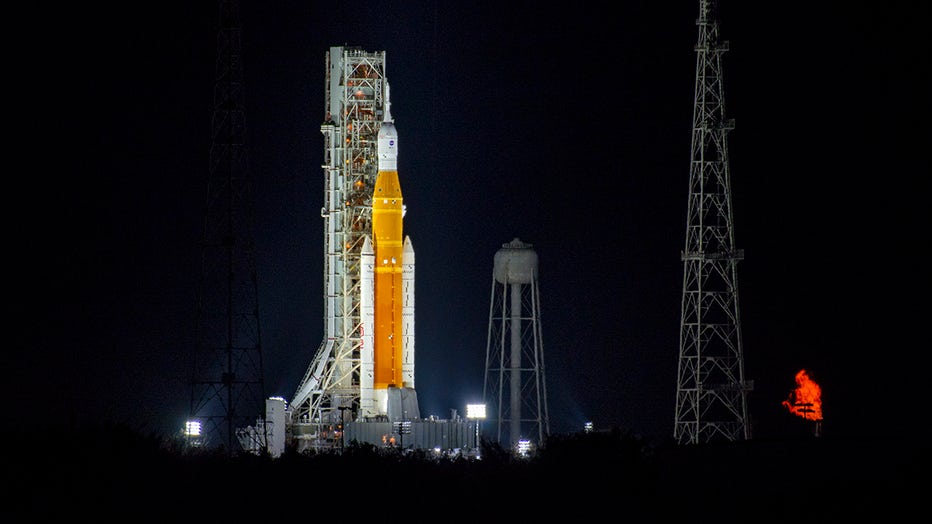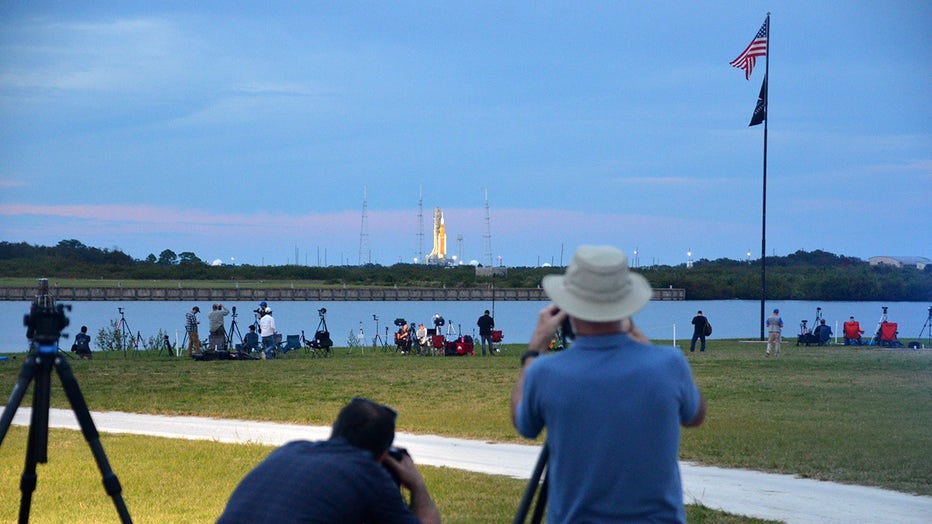Technical issues challenge NASA ahead of latest moon rocket launch
CAPE CANAVERAL, Fla. - NASA says a risky repair job appears to have fixed the hydrogen fuel leak that threatened to delay a third attempt to send the Space Launch System rocket and Orion spacecraft on a test flight known as Artemis I, and liftoff could be minutes away.
The SLS was scheduled to launch the unpiloted Orion to the moon during a two-hour launch window Wednesday that opened at 1:04 a.m. Eastern. Loading the 322-foot-tall rocket with more than 750,000 gallons of cryogenic fuel began around 4 p.m.
WHAT IS NASA'S ARTEMIS 1 MISSION GOING TO DO?
The rocket had to be slowly filled with liquid oxygen and liquid hydrogen propellant. Hydrogen, a tiny molecule, has created problems for NASA during the last two launch attempts. To avoid these issues, Launch Director Charlie Blackwell-Thompson said the team planned a "kinder, gentler" approach to tank the rocket.

NASA's SLS rocket undergoes fueling after sunset on November 15, 2022. (FOX photo)
Two previous launch attempts – one in late August and the other in September – ended in launch scrubs due to technical issues with fueling the rocket with super-cold liquid hydrogen, which commonly leaks.
About six hours before liftoff as the sun set on the SLS rocket, fueling continued without issue. But by 9:30 p.m., a new leak had developed at a valve along the side of the mobile launch tower, forcing NASA to stop the flow of fuel. A so-called "red team" of specialists headed to the launch pad to tighten bolts on the valve by hand. The work took longer than expected, but just before 11 p.m., the crew headed back out from the pad after giving a thumbs-up to the cameras.
NASA later said fuel was again flowing into the SLS rocket. Separately, the Space Force was working to repair a bad ethernet switch that took a critical radar system offline, which delayed the launch past the opening of the window.
With those issues fixed, NASA was pressing ahead with a 1:47 a.m. launch time.
After two previous launch attempts and dealing with delays from hurricanes Ian and Nicole, NASA managers say they are hopeful that this time, everything will line up for the mega moon rocket designed to return humans to the moon by 2025.

NASA’s Space Launch System (SLS) rocket with the Orion spacecraft aboard is seen atop a mobile launcher at Launch Pad 39B as preparations for launch continue, Monday, Nov. 14, 2022, at NASA’s Kennedy Space Center in Florida. (NASA/Bill Ingalls)
"We're going to go when we're ready. We're learning the systems of this vehicle," NASA Associate Administrator for Exploration Systems Development Jim Free told reporters earlier this week.
When it happens, the SLS will blast off using more than 8.8 million pounds of thrust to send Orion on its journey around the moon. About 10 small spacecraft will be deployed in orbit as secondary payloads on the spaceflight to the moon. There are also manikins inside the spacecraft wearing special vests to examine the effects of radiation on future astronaut passengers.
MEET THE MANIKINS THAT WILL HITCH A RIDE ON NASA’S MOON ROCKET
Orion will travel about 40,000 miles beyond the moon's far side, farther than any human-rated spacecraft. This lunar orbit is known as the distance retrograde orbit or DRO.
The Artemis I test flight culminates with Orion's splashdown in the Pacific Ocean on Dec. 11

Photographers line up their shots of the SLS rocket at KSC's press site. (FOX photo)
Beautiful launch weather
The weather continues to be nearly perfect for a rocket launch that requires no rain, low wind speeds and specific temperatures.
Forecasters with the Space Force 45th Weather Squadron are predicting a 90% chance of favorable launch conditions for liftoff. Forecasters are monitoring slight chance of thick clouds, but they remain optimistic.
HOW TO WATCH THE ARTEMIS 1 LAUNCH ONLINE AND ON FLORIDA'S SPACE COAST
Launch viewers will enjoy pleasant temperatures in the 70s with winds around 10 mph. Coastal showers will remain far enough offshore and shouldn't interfere with the launch Wednesday.
Despite the early-hour liftoff, Florida's Space Coast will be bustling with people hoping to witness the history of NASA's mega moon rocket taking off for the first time. Launch viewers are encouraged to arrive earlier at their selected spot and expect traffic on State Road 528 and NASA Causeway.

NASA's SLS rocket is reflected in the waters of Kennedy Space Center's turning basin. (FOX photo)
The powerful SLS will produce a rumble heard around Florida as it moves away from the peninsula.
NASA will air live launch coverage of the Artemis I launch beginning at 10:30 p.m. Eastern Tuesday night.
LINK: Get updates on the countdown from FOXweather.com
More Artemis coverage
- Artemis I launch: Key milestones to track before liftoff
- How long did it take NASA to launch the first space shuttle?
- With Artemis I, NASA plans to plant seeds of inspiration – literally
- These recycled space shuttle parts are now powering Artemis I to space
- Snoopy returning to space as ‘zero-G indicator’ on Artemis I flight
- Artemis I’s LEGO astronauts: On a mission to inspire
- What are all those black and white dots on NASA's Artemis I SLS rocket?

